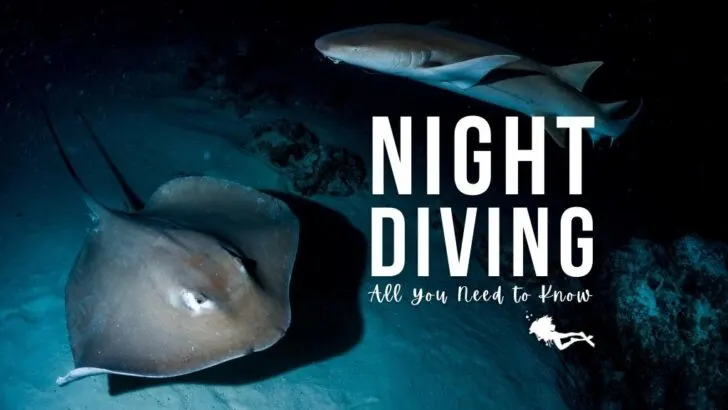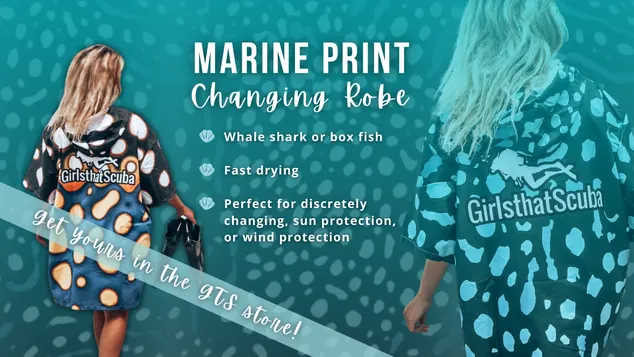Night diving provides a unique opportunity to marvel at some of the ocean’s most mysterious secrets. As darkness falls above the water, the world underneath it transforms. Familiar faces go into hiding and new ones emerge. Feeding and mating patterns change, and colours fade away and psychedelic patterns illuminate the water.
Night dives can certainly get your heart pumping, especially your first one. But they can be incredibly peaceful too. As you descend, the sounds of the day disappear, the weight lifts from your shoulders, and a serene stillness takes over.
Here, we’ll tell you everything you need to know about night diving. Whether you’ve logged heaps of night dives already or are about to take your first plunge – we’ve got you covered!
Is night diving dangerous?
Overall, night diving is very safe! Like all types of diving, though, night diving comes with inherent risks. Although these risks will vary from site to site, here are some key hazards associated with night diving.
Limited Visibility
Just like on land, when you’re underwater, the darkness makes carrying out ordinary tasks challenging. Of course, you’ll have a dive torch with you, but it’s not the same as having your usual vision. The reduced visibility can disorientate divers and pose difficulties in terms of navigating, finding your dive buddy, and spotting upcoming hazards.
Cold Water
Water can feel cooler at night than it does during the day. To avoid the risk of hypothermia, always make sure that your exposure suit is appropriate for night diving.

In some locations, you might need to add a pair of gloves or a hood to your suit. In others, you might have to switch from a wetsuit to a drysuit. It’s also a good idea to take a thermos of hot water with you on the boat, and some dry layers for after the dive.
Marine Life
At night, divers may be less aware of their surroundings than during the day. This means that you need to be extra careful to avoid contact with marine life. Not only can this damage the underwater world, but some species, like urchins and stinging corals, are particularly hazardous.
Also, some marine species may be more active or territorial at night than in the day, potentially posing an additional risk.
Psychological Factors
One of the biggest risks to a diver at night is in fact other divers… including themselves! Nerves can sometimes get the better of people during a night dive, and this can lead to poor decision making. This can be dangerous for divers and their buddies, so it’s especially important to check in with your buddy before the dive to see how they’re feeling.
Ultimately, there are some additional risks associated with night diving compared with day diving. However, as for all diving, by diving within your limits and following safety protocols, the risk of accident or injury is drastically reduced.
What certification do I need to go night diving?
There’s no hard and fast rule when it comes to night diving certification. Requirements tend to vary among tour operators. If you’re fairly new to the world of scuba, they may insist that you undergo a night dive speciality course. However, if you’re an experienced scuba diver, an in-depth briefing will be more than sufficient, without the need for you to have an extra certification.
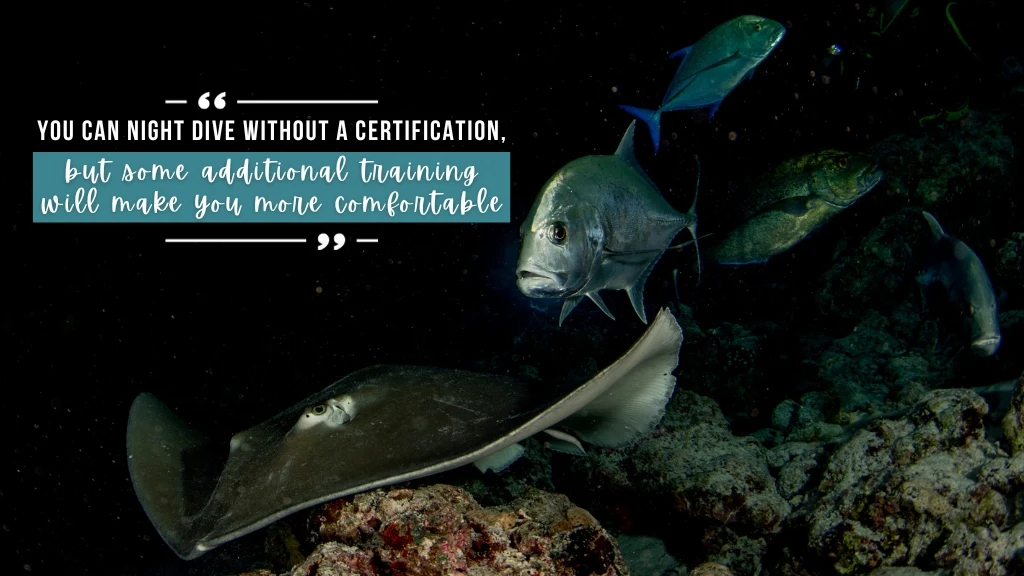
Even if you are new to scuba diving, some tour operators may let you dive at night without any formal training. Whether or not this is a good idea will depend on your personal comfort level, and the attentiveness of your night diving guide.
In short, you can night dive without a night diving speciality course, but some additional training will make you more comfortable which will only make your experience better!
The good news is that night dive courses are fairly easy to come by. Many international diving agencies, including PADI, NAUI, SSI and SDI/TDI, offer night dive specialties. Alternatively, it might be possible to incorporate a night dive as part of another training course, such as the PADI Advanced Open Water Diver course.
Although the content differs slightly from course to course, night dive specialties aim to mitigate the risks associated with scuba diving at night. On all courses, you’ll learn specialised techniques to navigate in the dark, maintain close buddy contact, communicate in the darkness… and much more!
Night diving signals
Just like when you dive during the day, when you dive at night it’s essential that you’re able to signal to your dive buddies. Because of the lack of light, divers typically use a combination of both hand and light signals to communicate at night.
To catch your buddy’s attention you can give them a tap or make a noise, like gently banging on your tank. You can also shine your dive light back and forth – this usually works well if you can shine it on the bottom.
Once you have their attention, you can use regular hand signals while shining a torch on your hand from above so your buddy can see it. Some signals will need to be adapted to one handed versions, though. Just be careful not to shine the light in your buddy’s eyes by mistake – it’s not nice (or safe) to be temporarily blinded underwater!
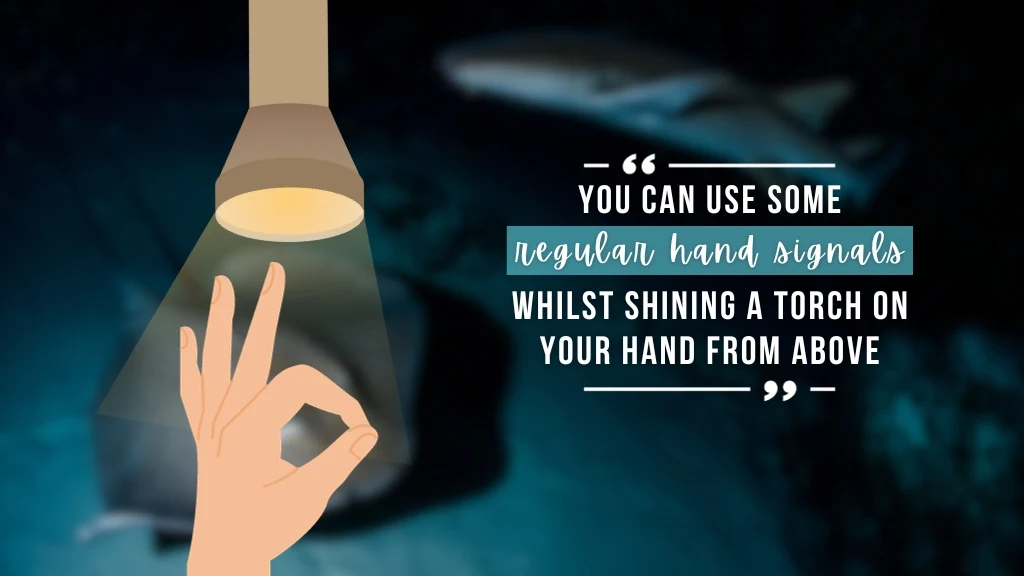
Alternatively, you can use your torch to draw shapes on the seabed or other surfaces. Some of the most common night diving signals are:
“Okay”
To other divers – move your torch in a large circular movement on the ground. To the boat – hold your light above your head, pointing downwards, while making the usual ‘okay’ shape with your arms.
“I have a problem”
Fast, side-to-side, horizontal movements.
“Attention”
Move your torch up and down.
But remember, signals can vary, so make sure you listen carefully during your dive briefing. It’s also a good idea to run through signals with your buddy before the dive.
What can I see when scuba diving at night?
And now for the fun part – exploring a new underwater world! Here’s some of what you might get to see whilst night diving.
You might see a new species
Many of the species you’ll be familiar with from daytime diving will go into hiding at night, but others will take their place. Species that are more active at night are said to be nocturnal. Nocturnal marine creatures include some types of shark, like nurse sharks and reefs sharks. Crustaceans, like crabs and lobster, are also nocturnal, as are many cephalopods – including cuttlefish and squid.
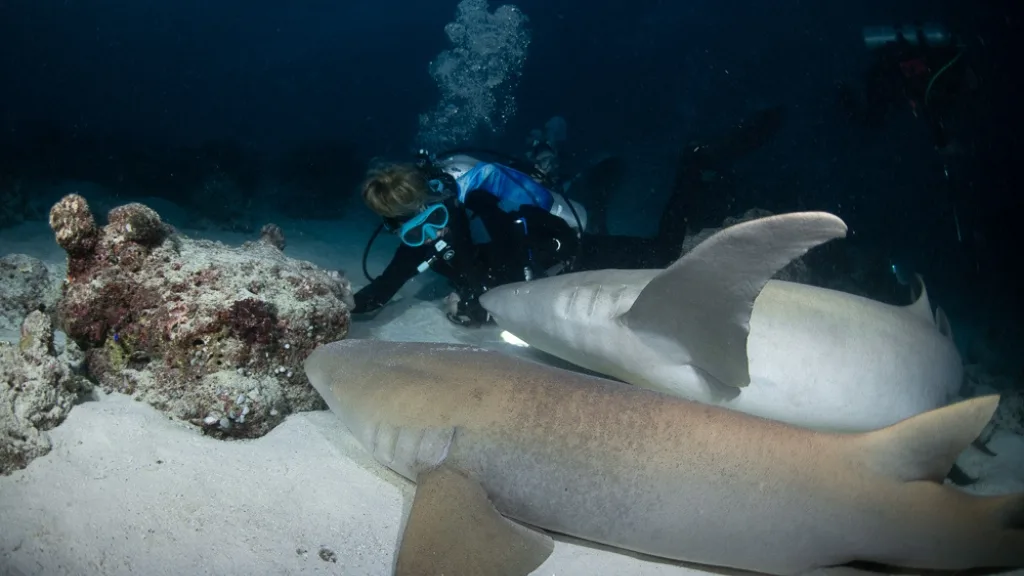
But why is this? Typically, marine species adapt their activity based on which species they want to encounter (i.e. prey, potential mates) or avoid (e.g. predators).
For instance, when sharks hunt during the day, they cast a shadow beneath them that can alert their prey to their presence. Yet at night, there is no shadow, which gives them an advantage.
What’s more, the dark colouring of a shark’s dorsal side (the top side) lets them blend into their surroundings at night. This makes them appear less obvious to animals that are swimming above them.
If you’re wondering whether the darkness makes it hard for sharks to spot their prey – the answer is no. Sharks have finely tuned senses of smell and electroreception. This electroreception enables sharks to detect electrical signals generated by the movement of other species. Because these senses don’t depend on daylight, sharks can use them to hunt at night.
On the flip side, shrimp prefer to forage at night so that they can avoid their daytime predators. Similarly, some fish species release their eggs (known as spawning) at night so they’re less likely to be consumed by egg eaters.
You might see the same species… acting differently
Even when you do spot a familiar species during a night dive, you might find it acting strangely.
For instance, several parrotfish species produce a protective mucus bubble at night. The bubble completely surrounds the parrotfish, a bit like a sleeping bag, and protects it from pesky parasites while it sleeps. Scientists think that the bubble may also mask the scent of the parrotfish, protecting it from predators.
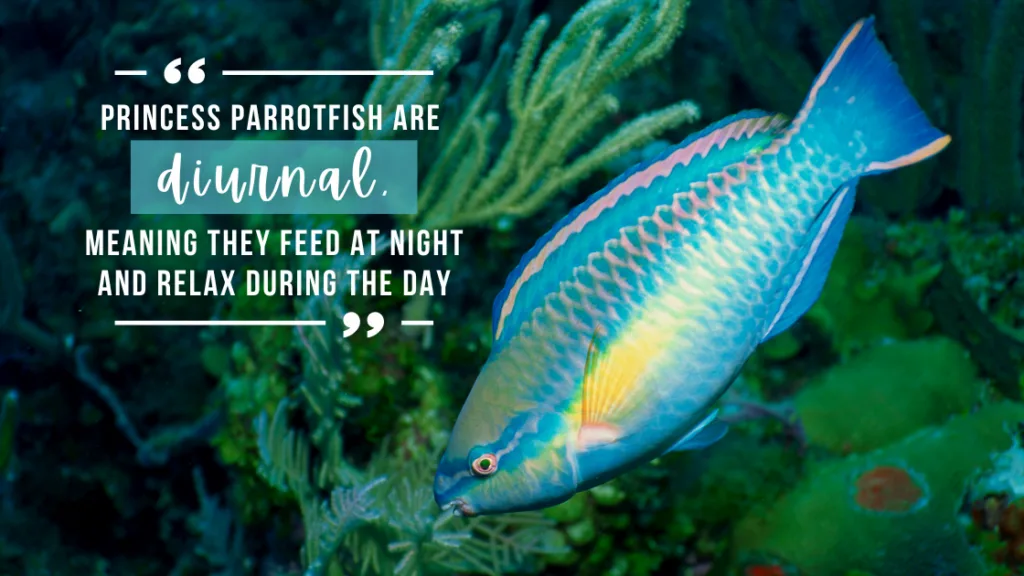
Night diving bioluminescence
Bioluminescence is light that’s produced by a living organism through a chemical reaction – and it’s one of the coolest things to see on a night dive.
There are lots of reasons why organisms use bioluminescence. For instance, the firefly squid uses its light to entice and detect small fish. As the squid rise to the surface to feed, their lights can form spectacular constellation-like patterns in the shallows.
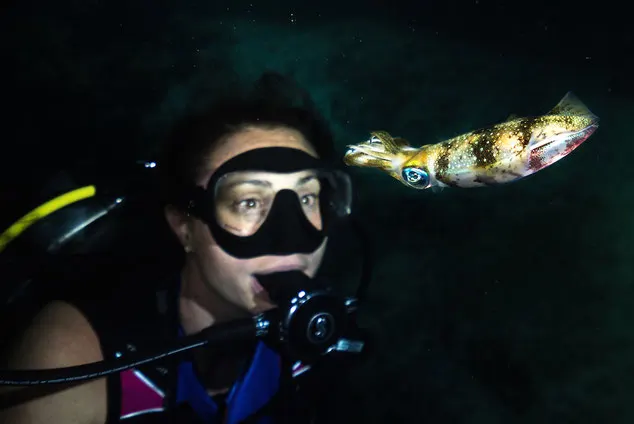
Bioluminescence can also be used for defence. For example, certain species of jellyfish produce intense bursts of light when threatened. This can startle or confuse predators, giving the jellyfish time to escape. Yet for other animals, such as Antarctic krill, the exact reason for bioluminescence remains unknown.
One of the most common forms of night diving bioluminescence is produced by a certain type of single-celled algae (known as dinoflagellates). These organisms emit bright blue light when disturbed – you can often spot them just by waving your arms in the shallows at night.
Where are the best places to go night diving?
Ready to get going on your next night dive? We don’t blame you! In case you need any travel inspiration, we’ve picked out a few of the world’s best places to night dive.
Kona, Hawaii
Even by day scuba diving with manta rays is a serene experience… so wait until you try it at night! There are lots of places where you can dive with mantas, but Kona Hawaii is a firm favourite for night excursions with our beloved gentle giants. It’s also renowned for blackwater diving!
Maaya Thila, Maldives
The Maldives is another great place for night diving (or any kind of diving, really). One site that’s especially good for night diving is Maaya Thila. Teeming with marine life, this spot is a great one if you’re keen to get a glimpse of some lively reef shark action.
Raja Ampat, Indonesia
If bioluminescence is your thing, then you’re going to love a night dive trip to Raja Ampat, Indonesia. It’s known for its cephalopods, which includes squids and cuttlefish, and lots of them are bioluminescent. There’s also plenty of bioluminescent plankton floating around in the shallows, which makes for a dazzling post-dive dip.
Red Sea, Egypt
This might not sound like an obvious night dive destination, but the Red Sea is home to some of the world’s best wreck dives. Exploring these, even from the outside, under the cover of darkness is an eerie yet fascinating experience.
Have you been night diving yet? Share this post with a buddy who needs to take the plunge into darker waters with you!

About the Author
Rose has spent the last few years living in Europe, the Seychelles and Kenya, working as a dive instructor, writer and conservationist. She’s back in the UK at the moment and is slowly acclimatising to cooler waters!

